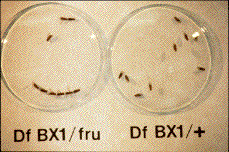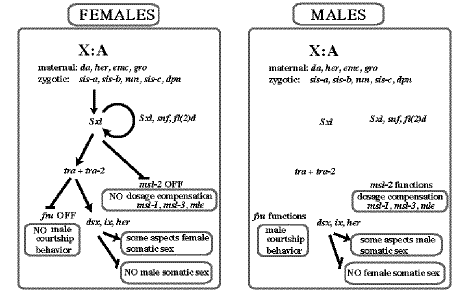12/12/96
Scientists identify gene for sexual behavior in male flies
A team of scientists from four universities has isolated the gene that
controls most or all sexual behavior in male fruit flies. Their research
is the first to pinpoint a single gene that works in the brain to govern
nearly all aspects of a complex behavior in adult animals.
The scientists from Stanford, the University of Texas Southwestern
Medical Center at Dallas, Brandeis University and Oregon State
University report their findings in the Dec. 13 issue of the journal Cell.

The gene fru governs the fly's courtship and
mating ritual, including its courting song. Here a male with a normal
copy of the gene lifts one wing and vibrates it in a rhythmic song, as
recorded on an oscilloscope below the drawing. Males with a slight
alteration, or mutation, of the fru gene have subtle changes in
their songs. With severe mutations, the flies do not sing a note, though
they can flick their wings and can use them to fly. (courtesy: Jeffrey
Hall, Brandeis University)
Geneticists have known for years that the gene, called fruitless
and nicknamed fru, influences sexual orientation in the fly
Drosophila melanogaster. Male flies with some mutations in the
fru gene become bisexual they cannot tell other males from
female flies when courting. With this research, the team of geneticists
cloned and isolated the fru gene, and showed that it controls
much more than the male's choice of partners.
They showed that the fru gene is:
- A master gene that controls not only sexual orientation but all, or
nearly all, the steps in the male fly's elaborate courtship ritual
from its first interest in a female through its rhythmic courting
song, to its attempts to mate.
- Part of a group of genes that work together to govern all aspects of
sex in these flies, including development of male and female organs.
- At work in a very small fraction of the cells in the fly's brain.
The properties of the fru gene's target neurons suggest that they
carry out command-and-control functions to set up and coordinate the
complex events of male courtship and copulation.
"There has been speculation recently that no single gene could control a
complex behavior. This work shows that a gene can do so at least
in fruit flies," said Stanford
biologist Bruce
Baker, one of the four
principal investigators of the study.

The gene fru governs the fly's courtship and
mating ritual, including the male fly's ability to recognize a female.
Males with a normal copy of the gene, at right, pursue only females.
Males with an alteration, or mutation, of the fru gene, at left,
court both sexes, and sometimes form chains with each male courting the
one in front of it. (courtesy: Jeffrey Hall, Brandeis
University)
The lead author on
the Cell article is Lisa Ryner,
a research
associate in Baker's lab at Stanford. The principal investigators on the
National Institutes of Health-sponsored study are Baker, professor of
biological sciences at Stanford and an expert on the molecular genetics
of sexual differentiation; Steven Wasserman, associate professor of
molecular biology and oncology at UT Southwestern, an expert on the
molecular genetics of fertility; Jeffrey Hall, professor of biology at
Brandeis University and an expert on genetics and fly sexual behavior;
and Barbara Taylor, assistant professor of biology at Oregon State
University and an expert on genetics and the fly's nervous system.
Co-authors include postdoctoral research fellow Stephen F. Goodwin and
research associate Adriana Villella of Brandeis; postdoctoral fellow
Anuranjan Anand of Stanford; and Diego H. Castrillon, formerly an
M.D./Ph.D. student at UT Southwestern, now a resident in pathology at
Brigham and Women's Hospital and Harvard University Medical School.
"These findings on fru provide a starting point for a whole host
of other studies, to learn how sexual behavior and sexual orientation
are specified by genes and controlled by the nervous system," Wasserman
said.
"Our data so far suggest that fru is involved in interactions
between a handful of specific brain cells that in some way direct the
various steps of male courtship behavior and copulation," Taylor said.
"This is an important tool here we have a gene that allows us to
extract some behavioral element and then go into the nervous system and
see how it is organized."
"This is a spectacular example of the value of open exchange at
scientific conferences," said Wasserman. The labs joined forces at an
international meeting when he and Baker realized that each of their
groups had half the essential information needed to clone and understand
the role of the fru gene. "We had a map, and they knew where the
crucial point in the map was," Wasserman said. "To go on and understand
how the gene works called for the skills of the other two labs as well."

Important evidence that fru is the gene normally
controlling most male sex behavior in the fruit fly comes from the fact
that it fits in a hierarchy of genes that governs all other aspects of
sex as well. In Drosophila males, "doublesex" (dsx)
commands the development of male sex organs and other male
characteristics, while "fruitless" (fru) commands male sexual
behavior. Genes higher up in the family tree act to turn off dsx
and fru so that female flies do not exhibit male sex organs
or male behavior. (courtesy: Bruce Baker, Stanford
University)
Could human sexual behavior be commanded by a single gene? So far, no
gene similar to fru has been found in humans or other animals.
But geneticists have been studying fruit flies for more than 80 years to
learn how genes instruct the building of the fly's body and the function
of its cells, and insights from that work have already helped explain
how the human body develops.
"In any complex organism, brain formation and function must be
controlled in part by genes," Hall said. "The question is not whether
but how do the actions of a given gene influence some interesting aspect
of behavior."
However, he said, "Even if a gene of this sort could be identified in
humans, that does not mean it would solely 'determine' behavior. By
definition, those actions are also influenced by upbringing and
environment even in flies."
-30-
-By Janet Basu-
REPORTERS NOTE: There are several indirect ways in which genes have been
found to affect a fly's sexual behavior. For example, last year NIH
researchers made headlines when they altered a gene for eye color so
that it was expressed in every cell in the fly's body. In some cells,
the altered eye-color gene triggered abnormal changes so that male flies
courted other males. In contrast, the Dec. 13 Cell paper reports
on the characterization of a gene that works within a group of genes
governing all aspects of fruit fly sex. The research shows that this
gene normally acts in the central nervous system of all male flies to
specify sexual behavior.
ART EDITOR: Photos and art to accompany this story are available by
anonymous ftp at ftp://36.15.0.227/images look for the "fly art"
folder.
All images are embargoed until 5:00 p.m. EST on Thursday, Dec 12.
To obtain a copy of the scientific paper in
Cell call (617)
661-7057, ext. 138.


